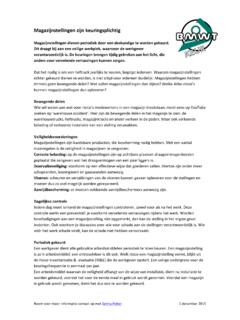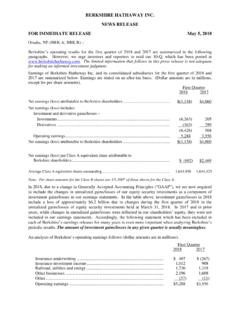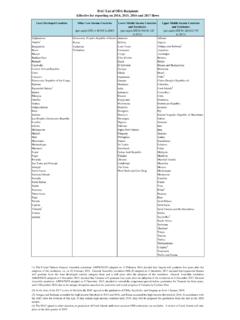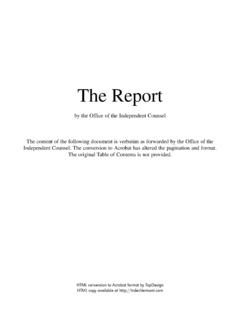Transcription of Carrousel Tug Design - imcgroup.nl
1 Day 4. Paper No. 4. Carrousel Tug Design Dr. M. van der Laan, IMC, the Netherlands SYNOPSIS: Nowadays tug Design can be characterized by keeping the hull direction in line with the towing wire and rotating the thrust force 360-degree around. The new Carrousel tug Design can be characterized by rotating the hull direction free from the towing wire. This Carrousel consists of a large horizontal ring, rotating around the accommodation and fitted with the towing wire. The attachment in the side reduces the heeling moment sharply and enables to use the full extent of the dynamic hull forces for escorting (steering and braking) to be used. Fig. 2 The effect of a radial support (C) and normal Fig. 1 Scale model of the Carrousel on a conventional attachment (N). Combi tug For conventional tugs, this support was placed near the center of lateral resistance (CLR). With the newer tug and propulsion types appearing, the towing point was moved away from the CLR towards bow or stern to ensure that 1.
2 Introduction an overload' in the towing wire would lead to a rapid turn of the hull axis in line with the force and thereby prevent capsizing. This feature in combination with wide-bodied Present Design focus on propulsion hulls offers a fairly good protection against capsizing The past 20 - 25 years Design of harbor tugs has instead of the radial support and is widely applied on concentrated on developing and improving the propulsion modern ASD and tractor tugs. and the associated maneuverability. Propulsion moved from single to double prop, various nozzles and rudder types were introduced and finally the propulsion New towing wire attachment: The Carrousel developed into omnidirectional thrust by two or more This paper describes a new revolutionary patented thrusters [1], [2] or VSP [3]. This development forms the approach to connect the towing wire to the ship's hull with base of the present day tendency of fully omnidirectional a full circular ring, the so-called Carrousel .
3 This Carrousel propulsion with ever increasing bollard pull and with to a offers three important features: lesser extent use of hydrodynamic forces by skegs and/or box keels [4] and [5]. 1) All around flexibility The Carrousel ring can rotate freely all around without limitations and towing operations can be freely changed Little focus on towing wire attachment from bow to stern use or vice versa, see fig. 3. In contrast to the extensive developments in tug propulsion, relative little developments were seen in the towing wire attachment to the ship's hull. Already dating back to the fifties, many tow hooks were based on some kind of radial support ( Seebeck patent') using a half circular vertical guiding support of the towing hook to move the attachment point towards the side and thereby reduce the heeling arm, see fig. 2. Radial supports have also been used to support fairleads instead of towing hooks.
4 For further recent developments on radial support, see [6]. Fig. 3 All around flexibility by Carrousel 233. Day 4. Paper No. 4. 2) Large stability enables to increase hydrodynamic forces The Carrousel is based on the same principle as a radial Design study: Thrust Lift Liner (TLL). hook, but now extended to the full ship's width. Hereby a The Thrust Liner was purely based on bollard pull and low large increase in stability is achieved, which can be used speed assistance. For higher speed assistance the use of to increase the hydrodynamic forces. hydrodynamic forces was investigated by large skegs below the Carrousel , leading to the following logical 3) Towing wire attachment point near lateral centre solution: Keep the Thrust all around and the The stability feature enables to position the Carrousel right hydrodynamic Lift forces in transverse direction above the center of the lateral resistance and thereby in line with the towing Line maximize the towline forces and minimize the need for steering propulsion on the tug.
5 This solution could be achieved by a double skeg arrangement below the Carrousel and a twin thruster The Carrousel is independent of the propulsion type and arrangement: One thruster in the bow (SB) and one can therefore be applied to any type of tug Design and mirrored aft (PS). By this arrangement, the center of the propulsion type (and to a wide variety of smaller sized thrust remains all around below the Carrousel and the workboats). However, in this phase already special heading of the hull can be controlled. attention is drawn to the attractive combination of the Carrousel with conventional shaft propulsors. This combination raises the performance of conventional' tugs to a significant higher level, leaving many of the clear drawbacks of these tug types behind. The Carrousel is still in an ongoing development and practical experience will finally determine the overall performance and use as stern and/or bow tug(s).
6 Therefore in this phase, all comments and criticism are welcome to assist the development, the application of the Carrousel and to improve the Design in a joined effort. Fig. 5 Thrust Lift Liner in side view Special attention is also drawn to the safe operational deck procedures for the freely rotating winch for both Design study: Carrousel on conventional tug stern and bow area. Although the effectiveness of the TLL was without any doubt, the necessity of thrusters was discussed and the One topic of further development is the Design of a associated increase in draught (similar as for tractor compact winch on the rotating Carrousel . tugs). Further developments lead to the focus on longitudinal shaft propulsion and transverse hydrodynamic forces, with the following solution. Keep the thrust longitudinal and the hydrodynamic lift 2. Development of the concept forces transverse in line with the towing line.
7 This solution could be achieved by a double skeg arrangement Background below the Carrousel and conventional single/twin During the on-going development of various new tug propulsion aft, possibly assisted by a small (retractable). concepts, the Carrousel itself formed a clear and thruster in the bow. important step forward and is therefore considered in detail in this paper. The Design options are summarized in table 1 below: Design study: Thrust Liner (TL) Carrousel THRUST LIFT. In 1997, IMC started a preliminary Design study for future development below towline below towline tug development in the Port of Rotterdam, with a clear Thrust Liner Centered 360 - focus on harbour assistance: Low towing speeds, large (TL) degree around bollard pull and little hydrodynamic lift / drag forces. Thrust Lift Liner Centered 360 Centered (TLL) degree around transverse only The most logical solution for this setting is based on a Conventional Centered Centered force vector diagram : Keep the Thrust vector all Carrousel Tug longitudinal transverse only around in line with the towing Line.
8 This solution could only be achieved by one thruster located below a freely Table 1 : Carrousel development rotating winch around the accommodation. Functioning The Carrousel offers three new functional aspects: All around flexibility Traditionally tug Design concentrated on towing over the stern behind the accommodation offering a free range of slightly more than 180 degrees for the towing wire. However, for many jobs more freedom is required and therefore the hull is turned 180 degrees. Modern ASD. Fig. 4: Thrust Liner in side view tugs use the same principle and rotate the whole hull and towing wire around the thrusters. 234. Day 4. Paper No. 4. However, the thought of easily changing towing over The dynamic towline aspects are described in chapter 4. stern to bow or vice-versa, has always been an ideal for on model testing and show no danger for capsizing due tug operators. to dynamic towline forces.
9 However, other external forces may still lead to capsizing of the tug ! Further, since the towline attachment point coincides with the CLR, changes in towline loads do no longer turn the What are then the practical implications? In order to take tug's hull direction. This enables to control the hull and advantage of this large radial support of the Carrousel , the sailing direction properly and offers a whole range of new tug must heel to a certain degree (typical 10 15 degrees). opportunities in assistance. to counter the large towing forces. Therefore, already in the Design stage, due consideration of these angles on Two typical examples, one for aft tug, second for bow tug, the functioning of the machinery and crew must be see fig. 18 and 19: included. I) Aft tug sails bow first with towing wire over bow (A): The traditional danger of deck immersion as last a) To brake the ship at higher speeds, the tug's warning before capsizing', is technically no longer hull is turned rectangular to the flow using the present for a Carrousel tug, although psychological still maximum hydrodynamic drag forces (wire over present!
10 Side) (B). b) To steer/pull the ship, the tug sails along outer Even a substantial amount of water on deck, leaves still circle forward and starts pulling the ship, (wire sufficient stability safety margin to ensure proper towing over stern) (E). operations. Also operations in exposed port areas with II) Bow tug sails bow first with towing wire over stern (I): significant wave heights can be performed safely. c) To brake the ship at higher speeds, the tug sails along outer circle aft and the hull is turned What is then the final limitation to towline force? Primarily rectangular to the flow, dragging alongside the the strength of the towing gear itself (including dynamic ship (wire over bow/side) (L). peak values) and the buoyancy of the tug's hull. Instead d) To brake the ship at lower speeds, the tug of the traditional heeling angle limitation, the master reverses and sails backward braking with full requires the practical use of a towline load tensioning bollard pull ahead (wire over stern).







